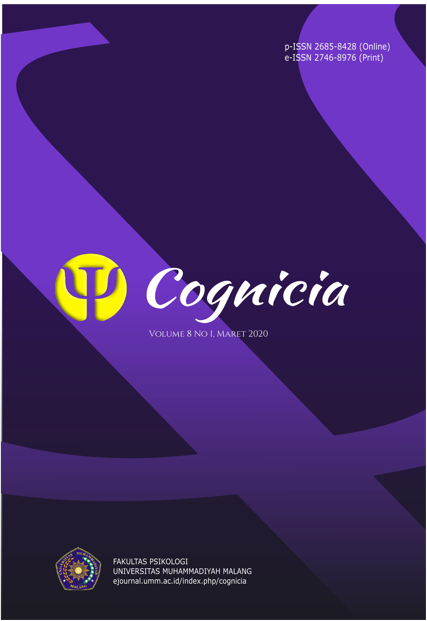Analisis stress dan penyesuaian diri pada mahasiswa
DOI:
https://doi.org/10.22219/cognicia.v8i1.11527Keywords:
stress, penyesuaian diri, mahasiswaAbstract
Mahasiswa membuat seseorang memiliki peran baru dalam dunia Pendidikan di Perguruan Tinggi. Ditemukan banyak perubahan dalam kehidupan barunya tersebut sehingga membutuhkan kemampuan penyesuaian diri yang baik. Kemampuan penyesuaian diri yang kurang baik dapat menyebabkan seorang mahasiswa mengalami stress. Hasil penelitian ini dapat digunakan sebagai dasar acuan pembinaan kemahasiswaan yang lebih sesuai dengan karakteristik masing masing individu yang selanjutnya dikelompokkan berdasar karakteristik yang berdekatan. Menjadi dasar pemberian perlakuan yang tepat agar hasil pembelajaran menjadi optimal. Pengumpulan data menggunakan skala stress dan penyesuaian diri. Tujuan penelitian untuk mengetahui gambaran stress dan penyesuaian diri mahasiswa. Subjek penelitian sebanyak 2320 mahasiswa. Hasil penelitian menggambarkan bahwa mahasiswa yang dalam kategori stres sedang sebanyak 55% , sebanyak 45 % dalam kategori stres rendah, dan tidak ditemukan tingkat stress yang dalam kategori tinggi. Adapun Penyesuaian diri mahasiswa dalam kategori sedang sebanyak 88%, sebanyak 11% berada pada level penyesuaian diri rendah, dan 1% yang berada pada level tinggi.
Downloads
References
Antony, M. M., Bieling, P. J., Cox, B. J., Enns, M. W., & Swinson, R. P. (1998). Psychometric properties of the 42-item and 21-item versions of the Depression Anxiety Stress Scales in clinical groups and a community sample. Psychological Assessment, 10(2), 176.
Aronson, J. (2004). The threat of stereotype. Educational Leadership, 62, 14-20.
Cook, C., Burgess-Limerick, R., & Papalia, S. (2004). The effect of upper extremity support on upper extremity posture and muscle activity during keyboard use. Applied ergonomics, 35(3), 285-292.
Crawford, J. R., & Henry, J. D. (2003). The Depression Anxiety Stress Scales (DASS): Normative data and latent structure in a large non‐clinical sample. British Journal of Clinical Psychology, 42(2), 111–131.
Desmita, D. (2009). Psikologi Perkembangan Peserta Didik. Remaja Rosdakarya.
Govaerts, S., & Grégoire, J. (2004). Stressful academic situations: Study on appraisal variables in adolescence. Revue Europeenne de Psychologie Appliquee, 54(4), 261–271. https://doi.org/10.1016/j.erap.2004.05.001
Gunawati, R., Hartati, S., & Listiara, A. (2010). Hubungan antara efektivitas komunikasi mahasiswa-dosen pembimbing utama skripsi dengan stres dalam menyusun skripsi pada mahasiswa Program Studi Psikologi Fakultas Kedokteran Universitas Diponegoro. Jurnal Psikologi, 3(2), 93–115.
Handoko, T. H. (2008). Manajemen Personalia dan Sumber Daya. Manusia (edisi 2). Yogyakarta: BPFE
Lazarus, R. S., & Folkman, S. (1984). Coping and adaptation. The handbook of behavioral medicine, 282325.
Joseph, E. (2009). An assessment of academic stress among undergraduate students: The case of University of Botswana. Educational Research and Reviews, 4(2), 63.
Kholidah, E., & Alsa, a. (2012). Berpikir Positif untuk Menurunkan Stres Psikologis. Jurnal Psikologi, 39(1), 67–75. https://doi.org/10.22146/JPSI.6967
Notosoedirdjo, M. (2000). Latipun. Kesehatan Mental Konsep dan Penerapannya. Malang.
Potter, P. A., & Perry, A. G. (2005). Buku ajar fundamental keperawatan: konsep, proses, dan praktik. Jakarta: Egc (Vol. 1).
Psychology Foundation of Australia. (2014). Depression anxiety stress scale.
Purwati, S. (2012). Tingkat Stres Akademik pada Mahasiswa Reguler Angkatan 2010 Fakultas Ilmu Keperawatan Universitas Indonesia.
Rathus, S. A., & Nevid, J. S. (2002). Psychology and the challenges of life: adjustment in the new millennium. Wiley.
Santrock, J. W. (1996). Adolescence: an introduction. Brown & Benchmark Publishers.
Schneiders. (1964). Personal Adjustment and Mental Health. New York: Holt, Reinhart & Winston Inc.
Smeltzer, S. C., Bare, B. G., Hinkle, J. L., Cheever, K. H., Townsend, M. C., & Gould, B. (2008). Brunner and Suddarth’s textbook of medicalsurgical nursing 10th edition. Philadelphia: Lipincott Williams & Wilkins.
Suryani, E. W., Hernawati, T., & Sriati, A. (2016). Psikoedukasi menurunkan tingkat depresi, stres dan kecemasan pada pasien tuberkulosis paru. Jurnal Ners, 11(1), 128–133.
Tyson, R. (1951). Current mental hygiene practice. Journal of clinical psychology, 7(1), 1-94.
Walsh, J. F. (2010). Psychoeducation in mental health. Lyceum Books.
Wong, D. L., Hockenberry, M. J., & Wilson, D. A. (2007). Wong’s nursing care of infants and children. St Louis, Mo: Mosby. This Page Intentionally Left Blank.
Woolfolk, R. L., & Lazarus, A. A. (1979). Between laboratory and clinic: Paving the two-way street. Cognitive Therapy and Research, 3(3), 239-244.
Yusuf, S. (2009). Mental hygiene: terapi psiko-spiritual untuk hidup sehat berkualitas. Penerbit Maestro: Bandung.
Downloads
Published
How to Cite
Issue
Section
License
Copyright (c) 2020 Yudi Suharsono, Zainul Anwar

This work is licensed under a Creative Commons Attribution-ShareAlike 4.0 International License.
Authors who publish with Jurnal Cognicia agree to the following terms:
- For all articles published in Jurnal Cognicia, copyright is retained by the authors. Authors give permission to the publisher to announce the work with conditions. When the manuscript is accepted for publication, the authors agree to automatic transfer of the publishing right to the publisher.
- Authors retain copyright and grant the journal right of first publication with the work simultaneously licensed under a Creative Commons Attribution-ShareAlike 4.0 International License that allows others to share the work with an acknowledgment of the work's authorship and initial publication in this journal.
- Authors are able to enter into separate, additional contractual arrangements for the non-exclusive distribution of the journal's published version of the work (e.g., post it to an institutional repository or publish it in a book), with an acknowledgment of its initial publication in this journal.
- Authors are permitted and encouraged to post their work online (e.g., in institutional repositories or on their website) prior to and during the submission process, as it can lead to productive exchanges, as well as earlier and greater citation of published wor (See The Effect of Open Access).

This work is licensed under a Creative Commons Attribution-ShareAlike 4.0 International License







